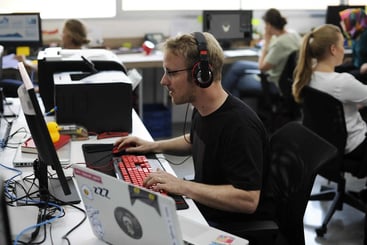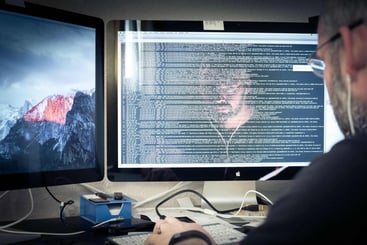Prepare For the Worst with the Best in the Business
Experience capable, consistent, and easy-to-use business continuity management software.
As of March 2025, 22.8% of US employees worked remotely at least partially, which accounts for 36.07 million people.
Protecting your employees from disaster while they’re working remotely is an important aspect of your business continuity plan.
Strengthen Your BC Plans
While companies are now used to having remote and hybrid workers, it would be a mistake for either the C-suite or the business continuity management (BCM) office to get complacent about their remote-work solutions.
The shift to remote work has also created unprecedented new vulnerabilities that BCM teams have never had to give much thought to before.
Two events show why we still have work to do in terms of hardening our remote-work solutions.
The first is Zoom outages. These have happened regularly since 2020.
The second event is more frequent hurricanes across the United States. These blackouts are predicted to become more normal.
As well as just hurricanes, natural disasters are increasing and cause difficulties for workers. Winter storms and wildfires both cause power outages.
The cost of these problems for businesses would be substantial.
6 Key Threats Facing Remote Workers
Homes are less resilient than office buildings to power and network outages. These are the six main threats to home-based workers:
1. Power outage
Electricity outages are the biggest potential threat to the productivity of home-based workers. Business continuity teams need to think about how they would respond if a loss of electrical power prevents key staff or large numbers of staff from doing their jobs.
Your BCM plan should also consider the impact of the related issue of power spikes. Organizations should analyze developing policies on the use of surge protectors. Companies should identify critical roles and equip the people in those roles with gear such as uninterruptible power supplies (UPS) that will enable them to keep working even if the local power goes out.
2. Network outage or slowdown
With so many people working and studying from home, networks are mobbed, performance can be slow, and outages are more likely.
Business continuity teams should consider providing backup internet connections, using alternate ISPs, for people in critical roles.
3. Natural disaster
Millions of people have been impacted by natural disasters across the USA just in 2025. FEMA has a list of 50 disasters declared in 2025, and in the first quarter of 2025 natural disaster losses totaled 110 billion USD. . Storms often result in the loss of power. What about situations where people have to evacuate their homes? Would these employees be able to work? How can you help them?
Business Continuity planners need to look at what they could do with employees who are required to move because of a natural disaster.
In the future, I can see companies setting up hardened regional hubs where people could go to continue doing their jobs even if they have to leave home.
4. Loss of critical applications
Companies have never been more dependent on massive cloud-based apps like Zoom, Teams, Google Meets, and Slack, and those apps have never been under greater strain.
Companies should have at least three remote meeting apps set up and ready to go. Don’t put all your eggs in one basket. There will be outages. Strive for redundancy.
5. Loss of physical device
Another significant issue is what happens if critical devices are stolen from someone’s home?
Your business continuity plan should include having some extra devices available and how quickly you could deliver them to employees.
For more on this issue, see Richard Long’s post on the MHA blog, “Homefront: The New Hot Zone for BCM Is Employees’ Home Offices.”
6. Loss of communication with the organization
Organizations need to make sure they can get in touch with their employees working remotely, and these ways need to be robust and redundant.
The BCM team needs to develop a strategy to disseminate information to all, whether by phone, email, or emergency notification system (ENS).
For more on ENS solutions, see How to Create an Emergency Response Plan.
Using Business Continuity Software to Create Better Plans
To improve your business continuity plans and protect remote and hybrid workers, you could use BC software.
Using online business continuity management solutions, you can:
- Strengthen the security of vital procedures,
- Improve your compliance with industry frameworks,
- Build plan templates,
- Easily edit recovery plans,
- Centralize your BC program in one place,
- Integrate your BIA information,
- Simplify reporting.
Hardening the Remote Work Solution
By and large, companies have done a great job in implementing remote-work solutions.
However, remote and hybrid employees face unique threats to their ability to do their jobs.
Remote workers are more vulnerable than office workers to power, network, and app outages, among other problems. Business continuity teams should harden their remote-work solution by providing redundant resources for home workers, especially those in key roles.
BCMMetrics: Practical Tools from Proven Experts
BCMMetrics was created by the business continuity experts at MHA Consulting. These are professionals who have spent decades in the field and understand what it takes to build and maintain a resilient organization.
The platform is cloud based and purpose built to support your entire BCM program. It helps you document recovery plans, run risk assessments, complete BIAs, and track program maturity over time.
BCMMetrics makes it easy to manage all the moving parts. You get clarity and control without the complexity of traditional enterprise tools.
If you are looking for software that works the way real BCM teams do, BCMMetrics is worth a closer look.
Explore the platform on your terms. No sales calls. No pressure. Take the virtual tour.

Michael Herrera
Michael Herrera is the Chief Executive Officer (CEO) of MHA. In his role, Michael provides global leadership to the entire set of industry practices and horizontal capabilities within MHA. Under his leadership, MHA has become a leading provider of Business Continuity and Disaster Recovery services to organizations on a global level. He is also the founder of BCMMETRICS, a leading cloud based tool designed to assess business continuity compliance and residual risk. Michael is a well-known and sought after speaker on Business Continuity issues at local and national contingency planner chapter meetings and conferences. Prior to founding MHA, he was a Regional VP for Bank of America, where he was responsible for Business Continuity across the southwest region.
.png)
.png)



